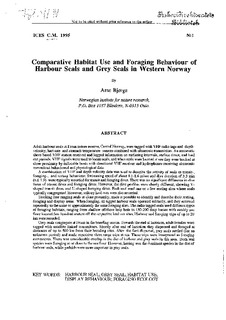| dc.description.abstract | Adult harbour seals at Froan nature reserve, Central Norway, were tagged with VHF radio tags and depthvelocity,
hart rate and stomach temperature sensors combined with ultrasonic transmitters. An automatic
shore based VHF station received and logged information on surfacing intervals, surface times, and haul
out periods. VHF signals were used to locate seals, and when seals were located at sea they were tracked at
dose proximity by inflatable boats with directional VHF receiver and hydrophones receiving ultrasonic
transmitted behavioural and physiological data.
A combination of VHF and depth-velocity data was used to describe the activity of seals as transit-,
foraging-, and resting behaviour. Swimming speed of about 1.1-1.6 ml sec and dive duration of 3.3 min
(s.d. 1.9) were typically recorded for transit and foraging dives. There was no significant difference in dive
times of transit dives and foraging dives. However, the dive profiles were dearly different, showing V-shaped
transit dives and U-shaped foraging dives. Each seal used one or a few resting sites where seals
typically congregated. However, solitary haul outs were also recorded.
Tracking free ranging seals at dose proximity, made it possible to identify and describe their resting,
foraging and display areas. When foraging, all tagged harbour seals operated solitarily, and they returned
repeatedly to the same or approximately the same foraging sites. The radio tagged seals used different types
of foraging habitats, ranging from shallow offshore kelp beds to 150-200 deep basins with muddy sea
floor located few hundred meters off the respective haul out sites. Harbour seal foraging trips of up to 20
km were recorded.
Grey seals congregate at Froan in the breeding season. Towards the end of lactation, adult females were
tagged with satellite linked transmitters. Shortly after end of lactation they dispersed and foraged at
distances of up to 500 km from their breeding sites. After the first dispersal, grey seals settled (for an
unknown period) and made repetitive short range trips at sea. These trips were interpreted as foraging
movements. There was considerable overlap in the diet of harbour and grey seals in this area. Both seal
species were foraging at or dose to the sea floor. However, herring was the dominant species in the diet of
harbour seals, while gadoids were more important in grey seals. | no_NO |
